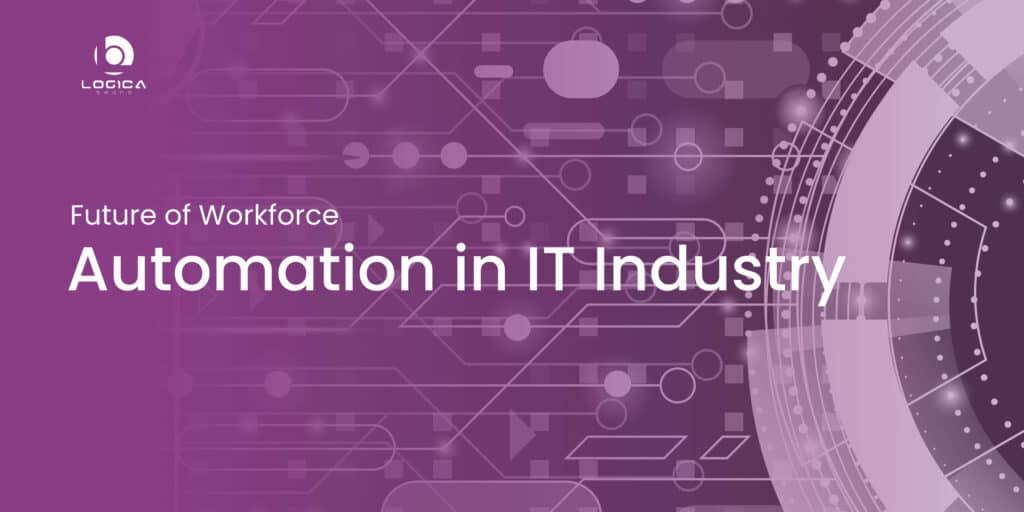The way we operate is changing along with the rest of the world. The IT sector is not an exception to how quickly sectors are changing as a result of automation technologies. The future of labor automation in the IT sector is shaping up to be a game-changer, thanks to robots and machine intelligence. It is hard to overlook the influence of workforce automation in IT industry has given its ability to boost productivity, improve customer experience, and generate new employment prospects.
Although the idea of automation is not new, current developments in AI and machine learning have made it feasible to automate increasingly intricate jobs and processes. Concerns have been raised regarding how automation would affect the workforce as a result, with some anticipating that it will result in massive job losses and a fundamental change in how labor is performed.
Some counter that the workforce will change as a result of automation rather than necessarily losing jobs. Workers can adjust to new roles and responsibilities brought about by automation with the proper skills and training. In fact, automation may open up new career possibilities in fields like cybersecurity, machine learning, and data analysis.
It is important to consider the possible effects of automation on the workforce as it speeds up, including job displacement and the requirement for new training and skills. In order to be innovative and competitive, the IT sector in particular will need to adapt to these developments. This necessitates a strategic planning and development of the workforce as well as cooperation between business, government, and academic institutions.
So, let’s take a deeper look at workforce automation in IT industry and how it will change how we work in the future
Workforce automation in IT industry
Workforce automation is the process of automating jobs that would otherwise be done by humans using technology. Many technologies, including artificial intelligence, robotics, and software automation, may fall under this category. Due to the advantages of automation, businesses are now able to focus their employees on strategic initiatives rather than mundane or time-consuming jobs that may be accomplished by software or other devices.
Automation is not limited to administrative work; other sectors can benefit from these emerging technologies. Robotics and automation, for instance, may be employed in manufacturing to assemble items, lowering the need for manual labor and speeding up production. In the field of transportation, drones and autonomous vehicles can be utilized to move cargo, obviating the need for human drivers and enhancing safety. Automation technology in healthcare can be utilized to more precisely and accurately carry out operations and other medical procedures.
Nonetheless, there can be drawbacks to labor automation. Job displacement is a worry, as workers who did physical labor or repetitive jobs in the past could no longer be required. Economic inequality and unemployment may result from this. There could also be moral and societal ramifications, such worries about prejudice and the effects of automation on society as a whole.
As technology develops and organizations try to stay competitive by increasing efficiency and cutting costs, workforce automation is a developing trend across sectors. Businesses may save time, lower mistakes, and boost productivity by automating processes that were previously carried out by humans.
Employees are given more time to work on more important activities by automating repetitive business operations. To finish higher-order jobs that call for a little more flexibility, more sophisticated kinds of automation, like machine learning, may now be applied. Since these computer algorithms can learn over time, they can swiftly and efficiently sift through vast amounts of data before contextualizing it in a meaningful way to aid internal decision-making.
How is workforce automation used in IT industry?
Workforce automation in IT industry can be used to automate a variety of processes and operations, increasing productivity and lowering expenses. Examples of routine processes that can be automated with the help of software automation tools include software testing, deployment, and monitoring. These speeds up the process, requires less manual work, and lowers mistakes.
In the IT sector, artificial intelligence (AI) technology may be used to automate processes like natural language processing, picture identification, and data analysis that typically need human intellect. By identifying and responding to network security threats in real-time and minimizing the need for manual involvement, AI can be utilized to enhance cybersecurity.
AI may be used to speed up decision-making and data processing. AI may assist businesses in making better decisions by analyzing vast volumes of data and seeing patterns and trends that people might not notice right away. Yet, there are also moral and societal questions raised by the employment of AI in the IT sector. For instance, there is a chance that AI will be applied to maintain bias or discriminate against racial or ethnic groups. Organizations must make sure that the technology is being utilized responsibly and openly, and they must carefully assess the ethical implications of deploying AI.
Workforce automation in IT industry can provide significant benefits to organizations. By automating routine tasks and leveraging AI technologies, organizations can improve efficiency, reduce costs, and improve the quality of their products and services. However, it is important to consider the potential risks and downsides of automation and to take a thoughtful and responsible approach to implementing workforce automation in IT industry.
Benefits of workforce automation in IT industry
The IT industry is an area where workforce automation can have significant benefits. Here are some of the benefits of workforce automation in IT industry:
●Increased efficiency
IT employees may focus on more strategic and high-value duties by automating repetitive processes like data input, report preparation, and software testing. IT workers may save up a lot of time by automating these repetitive operations, which they can then use to enhance product quality, introduce new features, and solve challenging technical problems.
●Cost saving
By eliminating the need for manual labor, decreasing the likelihood of human mistake, and raising efficiency, workforce automation can result in considerable cost savings. Automating repetitious processes can also help businesses avoid hiring more people, which eventually results in cheaper labor expenses. Moreover, by delivering more dependable and regular outcomes, automation can aid in lowering the expenses related to downtime, mistakes, and maintenance.
●Improved accuracy and quality
Automation of the workforce can assist in increasing the precision and caliber of work. Automation reduces the possibility of human error, which can cause serious issues in the IT sector, such as typos or calculation errors. For instance, automated testing may make sure that software products are rigorously verified before being released, lowering the possibility of faults and mistakes.
●Enhanced scalability
Without hiring more employees, workforce automation may help businesses increase their operations. At busy periods, automation can manage a greater amount of work, negating the need for more people. This can assist businesses in improved task management and project delivery on schedule.
●Improved customer experience
The customer experience may be enhanced by automation by offering quicker response times, more accuracy, and more individualized care. Automated chatbots and customer care websites may offer round-the-clock assistance, cutting down on wait times and boosting client happiness. Automation can also assist in guaranteeing that client data is handled safely and with the proper privacy protections in place.
Challenges in workforce automation in IT industry
As with any major technological advancement, workforce automation in IT industry also brings certain challenges that need to be addressed. Here are some of the key challenges surrounding workforce automation:
●Job displacement
Jobs that were formerly carried out by people may be replaced by automation. More work automation is possible as automation technology develops and gets more sophisticated. In certain industries, especially those that primarily rely on physical labor, this might result in severe job losses. As a result, there may be worries about how automation may affect job rates and whether or not economic inequality would rise.
●Resistance to change
Resistance to change is a problem with labor automation. Some employees could be reluctant to accept new technology or may not have the necessary abilities to use it efficiently. This may cause people to oppose automation and be reluctant to accept the changes it brings. As a result, businesses may need to spend money on education and training initiatives to assist employees in adjusting to new technology and acquiring the essential skills.
●Skills gap
Automation of the workforce might make the skills shortages already present in some areas worse. If low-skilled employment is replaced by technology, there may be a rise in the need for highly trained employees. To run and maintain this new technology, there can be a lack of personnel with the requisite expertise. As a result, businesses may need to spend money on education and training initiatives to create a workforce with greater skill levels.
●Ethics and privacy concerns
Concerns concerning the ethical and privacy consequences of automation technology may arise as it becomes more commonplace. For instance, there can be issues with using automation to track and supervise employees or to decide whether to hire people or promote them. Concerns concerning the security of personal data that is gathered and handled by automated systems may also exist. To guarantee that automation technology is utilized in an ethical and responsible way, companies may need to create rules and procedures.
Future of workforce automation in IT industry
The duties and responsibilities of IT workers are anticipated to change significantly as automation technology grows more sophisticated and powerful. While there are numerous potential advantages to workforce automation, there are also some drawbacks, including the effect on employment rates, the need for further education and training, and the moral and privacy ramifications of the technology.
●Predicted trends
It is expected that workforce automation in IT industry would advance and become more advanced. Increasing the usage of AI and ML, integrating automation with cloud computing, and creating automation tools for cybersecurity and data analysis are some of the developments that are anticipated. Moreover, there could be a move toward automating more difficult processes, such project management and software development.
●Role of IT professional in the future
The job of IT professionals is anticipated to change toward more strategic and high-value duties as automation technology spreads. IT specialists may be in charge of overseeing and maintaining automation systems, creating new automation technologies, and advising and assisting other organizational departments. In addition, there could be a greater need for IT specialists with expertise in fields like cybersecurity, machine learning, and AI.
●Mitigating concerns
Organizations may need to concentrate on creating rules and processes to guarantee that automation technology is utilized in an ethical and responsible manner to allay worries about workforce automation. To do this, it may be necessary to create policies for the use of automation in hiring and promotion choices, check that automation systems are safe and adhere to privacy laws and offer staff training and education to assist them become used to new technology.
●Preparing for the future
To prepare for the future of workforce automation in IT industry, firms may need to invest in training a more highly qualified workforce. This can entail making investments in training and educational initiatives to advance workers’ expertise in fields like AI, ML, and cybersecurity. A strategy for integrating automation technologies into an organization’s operations may also be needed.
This strategy should include identifying areas where automation might be most useful and formulating a strategy for putting new automation tools into practice. To assist employees, adopt new technology and adjust to shifting roles and responsibilities, firms may need to concentrate on developing an innovative and adaptable culture.
Conclusion
The future of workforce automation in IT industry is both exciting and difficult in the future. As automation technology spreads, you may anticipate significant changes in your position and duties as an IT professional. Keep up of the most recent trends and advancements in automation technology and make an investment in your education and abilities if you want to be ready for the future.
You might also need to collaborate with your company to create rules and processes to make sure automation technology is used in an honorable and responsible way. Although there are worries about how automation may affect employment rates and the need for new skills and training, there are numerous potential advantages, such as greater productivity and cost savings.










